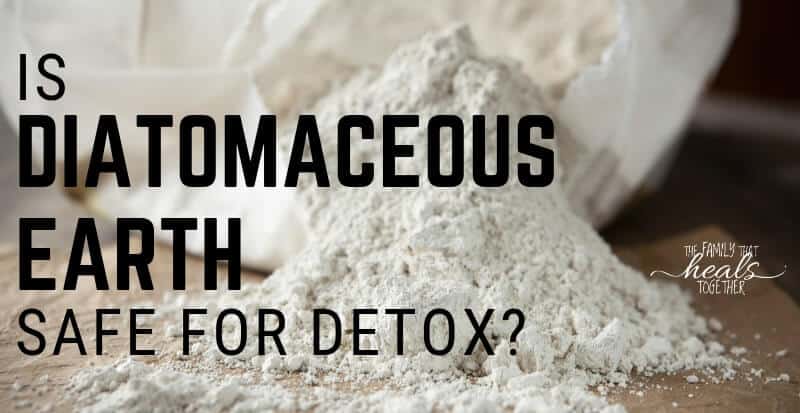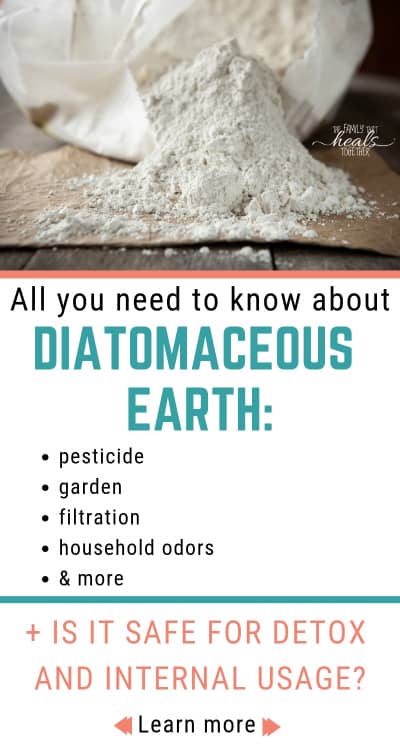The list of diatomaceous earth uses is long, from pest control and water filtration, to cleansing the body of parasites and lingering infections. But can you safely use it for detox?
As it turns out, there’s very little research on diatomaceous earth safety for internal use, but the Food and Drug Administration lists it as generally recognized as safe. With GRAS status, manufacturers can add food grade diatomaceous earth to food and supplements.
What is diatomaceous earth?
Diatomaceous earth (DE) is fine, sedimentary rock that’s made of the fossilized remains of diatoms – a type of single cell algae.
The cell wall of diatoms consists of biogenic silica, otherwise known as opal. When diatoms die, their remnants sink to the bottom of the ocean or lake floor. Silica-rich diatom deposits can be several hundred meters thick and are found all over the world.
These deposits are where we get diatomaceous earth.
Because of this, DE contains different levels of silica and clay, depending on where it is mined and the age of the deposit.
There are two types of diatomaceous earth.
- Food grade: Mostly made of amorphous or non-crystalline silica, it contains 0.5 – 2% of sharp crystalline silica. Approved by the FDA, agricultural and food industries use food grade diatomaceous earth. When shopping for DE, this is one to look for. (Like this.)
- Filter grade: Also known as non-food grade, this type of diatomaceous earth contains more than 60% crystalline silica. While toxic for us to take internally, you can use it for swimming pool maintenance.
Diatomaceous earth uses
Before jumping into the safety of diatomaceous earth for detox, let’s talk about proven diatomaceous earth uses.
Here’s what we know diatomaceous earth can do for you:
- It’s an insecticide: Bed bugs, dust mites, cockroaches, flies, ants, and fleas – be gone! DE absorbs oil and fat from an insect’s exoskeleton, causing it to dry out and die. Because DE is also abrasive, this speeds up the process. Just sprinkle where the bugs are and be careful not to inhale it.
- It works for garden pests too: If you’re wrangling aphids, slugs, snails, and other garden pests – you may want to use diatomaceous earth. But remember the bees! You can protect bee populations by avoiding the use of DE on flowering plants or on windy days.
- It nixes odor: Smelly garbage cans and trash bins aren’t fun. A sprinkle of DE controls odors and any bugs that said odor may have attracted. Works in kitty litter too.
- You can use it as a toothpaste and more: DE acts as a mild abrasive. Because of this, you can clean your teeth with it, polish metal, scrub sinks without harming porcelain, and even apply it as a face mask.
- It may reduce cholesterol: The only study of humans using diatomaceous earth as a supplement was published in 1998. Researchers report that taking DE internally for 8 weeks was linked to improved cholesterol and triglyceride levels. The only problem is that there was no control group, so it’s hard to say if DE was really responsible for better cholesterol levels.
- It binds to aflatoxin: There’s some evidence that diatomaceous earth can reduce the noxious effects of aflatoxin (toxins emitted by molds). But the science isn’t consistent. And the same can’t necessarily be said about diatomaceous earth for pigs.
- It rids livestock of parasites: In a study on organic, free-range poultry, researchers found that DE controlled both mite infestation and parasite load.
Is diatomaceous earth safe for detox?
Dr. Campbell-McBride, the creator of the gut-friendly GAPS diet, suggests using diatomaceous earth to help remove toxins from the body.
But it’s worth pointing out that most of us don’t need to detox as much as we need to gently soothe an inflamed, irritated, or triggered immune system. Typically, managing inflammation will give the detox effect of clearer skin, a better mood, and fewer health problems.
As you can see in the above list of diatomaceous earth uses, researchers have found some evidence that it can help livestock manage parasites and absorb toxins. But there’s almost no research on the use of DE in humans.
I had first heard about the calming effects of DE on kids with PANDAS through a Facebook group and decided to try it for myself.
I gave my son a tablespoon every day and felt shocked by how much it seemed to help him calm down.
But this wasn’t the only thing I was doing. For us, the real game-changer was oregano leaf tincture.
I have since learned that some folks say DE may irritate the gut lining. Because of this, I suggest that other families do their own research and decide if they feel comfortable using DE for detox.
Does diatomaceous earth strengthen skin, hair, and bones?
Many folks claim that DE can help hair and nails grow faster while getting rid of fine lines and wrinkles. And, yes, if you do a little digging, you will find research on silica to back up these claims.
Silica is a mineral that the body uses to make collagen – improving skin elasticity – as well as to build strong hair and nails.
That said, there’s still not enough information about the bioavailability of silica in diatomaceous earth.
How to use diatomaceous earth
Whether or not you decide to consume DE, always shop for food grade. This is the one we use at home.
If you decide to consume diatomaceous earth for detox, start with 1 teaspoon once a day with a glass of water on an empty stomach one to two hours before eating.
If you want, you can split the dosage between morning and night. Be sure to stay well hydrated and drink plenty of water when doing any detox; this includes cleansing with DE.
There’s no need to continually take DE. Some folks like to do diatomaceous earth detox for 90 days – 10 days on and 10 days off.
Because DE use may be hard on the gut, watch for any detox symptoms like a headache or low energy and take this as a sign that diatomaceous earth may not be right for you and your family.





